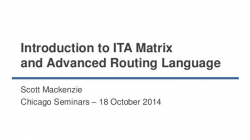Scott McCartney’s “Middle Seat” column is published every Thursday by The Wall Street Journal and is a regular read of mine. A lot of this stuff in rightly confusing, but he makes a good effort at laying out the details without oversimplifying. For those of you without a subscription, usually I find his articles are not trapped behind the WSJ’s paywall, and he also hosts a blog (with mostly WSJ articles, of course, but not all his own).
Today’s story, “Who’s the Fairest Fare of All?”, is about the dozens of online travel agencies (OTAs, like Orbitz or Travelocity) and search aggregators (like Kayak and Hipmunk) that most people use to book travel online. This is especially timely given the lesson plan I’ve been publishing this week on using ITA to search for airfare.
Remember that using ITA is great for finding the airline’s lowest published price. Why do all these websites quote different prices? Higher fares are most likely due to incomplete search results (several companies in the article admitted to filtering out certain options) and additional fees (an example from CheapOair increased the final price by $168). ITA doesn’t have those problems as long as your search isn’t overly broad and runs up against the one-minute search time limit. Lower fares are due to aggregators or other opaque booking processes that may not provide frequent flyer miles or that could leave you stuck on an undesirable itinerary you don’t see until after paying. Personally I’m not willing to take that risk.
So in short, I think ITA is probably still the best way to search for air travel. But because you also need to find a place to book your ticket found on ITA, Scott’s article may help you create a short list of which sites to check first. I often find what I need at the airline’s own site or from Kayak, but there are occasions when I have to try secondary options.
There is one better option than using ITA, which is to look up the fare schedule, a list of all published fares for a particular route. Each fare has a price and a list of rules attached. If you see a price you like, you can then try to match your travel plans to fall within the permitted rules. This is what ITA and other sites do already, but the problem is if you don’t fall within the rules, they don’t really tell you what conditions you need to meet to get the absolutely lowest price (fare calendars like ITA’s 30-day search are the closest approximation). There really are no better deals than what you’ll find with this method because you’re drawing from the entire published list.
Piecing together published fares with available inventory and understanding the fare rules is a more advanced task. I’ll get to it eventually, but for now I think the instructions I’ve provided on using ITA should satisfy most people’s needs.





